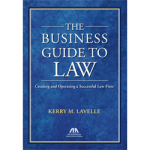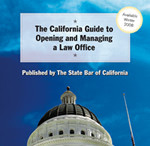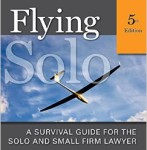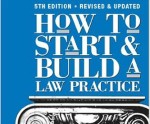 The San Francisco Law Library maintains a comprehensive Law Practice Management (LPM) Collection, with publications that detail all aspects of opening a practice—client relations, billing, marketing, finances, risk management, technology, and more. This post introduces the Law Library’s LPM resources that guide lawyers over the hurdles of opening a law firm.
The San Francisco Law Library maintains a comprehensive Law Practice Management (LPM) Collection, with publications that detail all aspects of opening a practice—client relations, billing, marketing, finances, risk management, technology, and more. This post introduces the Law Library’s LPM resources that guide lawyers over the hurdles of opening a law firm.
Stay tuned for future installments that highlight the Law Library’s materials on additional LPM topics.
The Business Guide to Law: Creating and Operating a Successful Law Firm, by Kerry M. Lavelle. American Bar Association, Solo, Small Firm, and General Practice Division, 2015.
 Author Kerry M. Lavelle acknowledges that there are many excellent books on how to open a law practice, but posits that his publication is unique—it is a business book.
Author Kerry M. Lavelle acknowledges that there are many excellent books on how to open a law practice, but posits that his publication is unique—it is a business book.
Indeed, in a profession where time is money, this book details how to effectively convert the former into the latter. Mr. Lavelle certainly doesn’t sugar coat the idea of running your own firm—he makes clear that starting a law firm is more akin to having two full-time jobs because of the need to both work in your business and on your business.
Read this book for no-nonsense tips on how much money to have in the bank to finance the first year, how to structure your workdays and weeks, how to choose a practice area specialization and so much more. With its business-centric approach, matter-of-fact tone, and comprehensive lists of best practices, The Business Guide to Law is essential reading for any solo practitioner or small firm lawyer.
The California Guide to Opening and Managing a Law Office. State Bar of California, 2008.
 With an eye toward the malpractice and disciplinary issues that stem from poor law practice management decisions, this guide from the State Bar offers sound advice for a successful solo practice.
With an eye toward the malpractice and disciplinary issues that stem from poor law practice management decisions, this guide from the State Bar offers sound advice for a successful solo practice.
This is easily one of the Law Library’s most popular LPM titles, and continues to be eight years after its publication. It details everything from how to negotiate an office lease and develop effective office procedures, to how to maintain personal relationships and set boundaries. Plus, it covers California-specific ethics, tax, and professional liability considerations that other guides lack.
Flying Solo: A Survival Guide for the Solo and Small Firm Lawyer, edited by K. William Gibson. American Bar Association, Law Practice Division, 5th ed., 2014.
 This comprehensive guide to running a solo or small practice boldly asks in its first chapter, “are you cut out for solo practice?” and notes that while solos can have it all, they need superior work habits, a fierce independent streak, and a strong support network to make it work.
This comprehensive guide to running a solo or small practice boldly asks in its first chapter, “are you cut out for solo practice?” and notes that while solos can have it all, they need superior work habits, a fierce independent streak, and a strong support network to make it work.
For already-employed lawyers, the guidance in chapter 5 is essential, as it details the step-by-step process of how to decide whether to open a firm, how to time your departure from your current firm, and what issues you must consider as you make the transition from practicing with a firm to solo practice. This book emphasizes that opening a law firm requires following a precise method to ensure success, and calls on leading solo practitioners to draft each chapter as a building block to a thriving practice.
How to Start and Build a Law Practice, by Jay G. Foonberg. American Bar Association, Law Practice Management Section, Platinum 5th ed., 2004.
 This LPM classic was the first book published by the ABA’s Law Practice Management Section. Highly regarded for its timeless advice, solo-seeking lawyers continue to consult it even now that the LPM advice market is saturated with options. Its short chapters offer author Jay G. Foonberg’s practical advice on virtually every conceivable question a lawyer would have when deciding to open a law practice. Mr. Foonberg’s take on home offices is particularly relevant here in San Francisco, where high rent costs make securing office space especially challenging.
This LPM classic was the first book published by the ABA’s Law Practice Management Section. Highly regarded for its timeless advice, solo-seeking lawyers continue to consult it even now that the LPM advice market is saturated with options. Its short chapters offer author Jay G. Foonberg’s practical advice on virtually every conceivable question a lawyer would have when deciding to open a law practice. Mr. Foonberg’s take on home offices is particularly relevant here in San Francisco, where high rent costs make securing office space especially challenging.
Solo by Choice: How to Be the Lawyer You Always Wanted to Be, by Carolyn Elefant. Decision Books, 2nd ed., 2011.
 Lawyers enter the legal profession with bright eyes and lofty ideals, but often find that reality takes over and their job is not at all what they had envisioned. Although many yearn for the satisfaction of regaining control over their legal career by going solo, they are discouraged by the inherent challenges of solo practice.
Lawyers enter the legal profession with bright eyes and lofty ideals, but often find that reality takes over and their job is not at all what they had envisioned. Although many yearn for the satisfaction of regaining control over their legal career by going solo, they are discouraged by the inherent challenges of solo practice.
At last—a book that tackles the naysayers and maintains that it’s never too late to follow your heart and take the reins of your own legal career by going solo. In fact, author Carolyn Elefant posits that in today’s entrepreneurial age, there has never been a better time for opening your own practice. She dispels common myths and fears about solo practice as she addresses the pros and cons of many complicated decisions. If you need help overcoming the negativity obstacle, this book can’t be missed.
About the author:
Andrea Woods is a Reference Librarian at the San Francisco Law Library.


